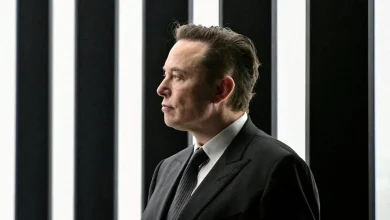Ksi Lisims LNG’s expected major project status puts spotlight on First Nations dispute

Open this photo in gallery:
An artist’s rendering of floating LNG facilities planned for the Nisga’a Nation-backed Ksi Lisims project. The project is facing legal challenges in Federal Court from two Indigenous groups in the Prince Rupert area.Supplied
The expected addition of the Nisga’a Nation-backed Ksi Lisims LNG venture to the federal government’s list of major projects puts Ottawa in the thick of the growing challenge over how to develop infrastructure opposed by neighbouring Indigenous groups.
Prime Minister Mark Carney said on Monday that his announcement on major projects of national significance would be made on Thursday. Ksi Lisims is expected to be on the list of major projects to be announced, sources told The Globe and Mail.
The Globe is not identifying the sources because they were not authorized to disclose the details publicly.
The expected inclusion places a spotlight on a complicated dispute that threatens to delay a project set to be deemed in the national interest.
The Nisga’a, Houston-based Western LNG and a group of natural gas producers called Rockies LNG are partners in the Ksi Lisims project near Gitlaxt’aamiks, in northwest British Columbia, which is home to the Nisga’a Lisims government led by elected president Eva Clayton.
The plan by Ksi Lisims to export liquefied natural gas from Nisga’a territory is facing two separate legal challenges in Federal Court from two nearby Indigenous groups in the Prince Rupert area, with one launched by the Lax Kw’alaams Band and the other by the Metlakatla First Nation.
Carney to add mining and energy projects to fast-track list, sources say
The Prime Minister’s Office said on Wednesday that the B.C. venue for the major project announcement has been changed to Terrace, about a 145-kilometre drive east of Prince Rupert, which was the original location.
The B.C. and federal governments both conditionally approved Ksi Lisims in September. Two floating production platforms are scheduled to be opened off Pearse Island in Nisga’a territory by 2029, with other vessels exporting LNG to Asia.
The Lax Kw’alaams and Metlakatla each applied last month for judicial reviews to quash the decision by federal Environment Minister Julie Dabrusin to give the green light to Ksi Lisims.
The North Coast Transmission Line (NCTL) project is also expected to make the list to be unveiled on Thursday for fast-tracking by the newly created Major Projects Office.
BC Hydro is proposing the NCTL venture, in collaboration with First Nations, which would run along the route of its current line between Prince George and Terrace.
Details to be worked out include how the estimated $6-billion in capital costs would be financed for the new transmission line. With the eventual addition of spur lines, the goal is to supply or increase electricity to customers such as the Port of Prince Rupert, mining companies and Ksi Lisims.
Ms. Clayton has touted Ksi Lisims and the associated Prince Rupert Gas Transmission (PRGT) pipeline project as prime examples of economic reconciliation. But Ksi Lisims and PRGT have become entangled in thorny issues marked by rising tensions and complications with nearby Indigenous groups.
Nisga’a Nation leader touts reconciliation after Ksi Lisims LNG project gains government approvals
On top of the Federal Court cases, PRGT is facing two separate legal challenges in B.C. Supreme Court. The petitioners in the B.C. Supreme Court cases are seeking judicial reviews to quash a ruling in June by Alex MacLennan, head of the B.C. Environmental Assessment Office, that the project has been substantially started. That decision paved the way for further construction on the pipeline project.
Western LNG chief executive officer Davis Thames has acknowledged opposition to both Ksi Lisims and PRGT.
“Canada is a democracy, and there are going to be people that think one thing and people who think a different thing,” Mr. Thames said in an interview last month. “You have a number of people who disagree and they have a forum, they have a voice and they’re using it, so that’s fine.”
Construction of the 750-kilometre PRGT project, which is co-owned 50-50 by the Nisga’a and Western LNG, would be across Northern British Columbia. In particular, the Gitxsan Nation and Gitanyow Nation both have traditional territories that the natural gas pipeline would cross.
The concept of exporting LNG from Nisga’a territory dates back to 2014.
Opinion: As Carney pushes major projects, he must heed a cautionary tale from Canada’s past
As the U.S. trade war persists, the federal government has been striving to smooth the way for economic diversification and reducing dependence on American customers. That led Ottawa to open the Major Projects Office in Calgary in August.
Canada produces much more natural gas than it consumes domestically, exporting 45 per cent of the total amount of the fuel that it produced last year to U.S. markets.
Shell PLC-led LNG Canada became the country’s first export terminal for natural gas in liquid form when it started shipments to Asia in June from Kitimat, B.C.
Mr. Thames said he believes in the global benefits of exporting the fuel, arguing that additional shipments from Canada could lessen the rate of emissions of greenhouse gases and air pollution in coal-consuming Asia.
But climate activists say Ottawa is propping up LNG, emphasizing that the focus should be on renewable energy instead of perpetuating the production of fossil fuels.
The David Suzuki Foundation said in a recent report titled Running on Fumes that the LNG industry has overpromised economic benefits and understated financial costs.
With a report from Robert Fife





